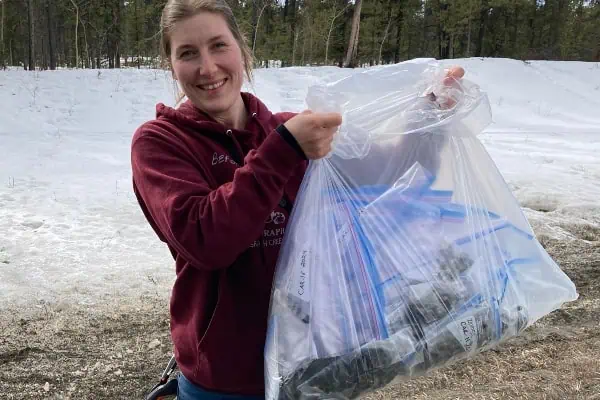Raspberries, blueberries, crowberries and cranberries: being on Yukon time means planning your weekends around where to pick once the – dare I say it? – latter part of summer rolls around and hints at fall.
There is one berry fairly new to the Yukon scene that is well over and done with by the time wild ones begin to ripen, however: the haskap. An anglicized version of the Japanese name (also written as hasakappu, hasakapa, hascap, and other variations), haskap is a domesticated version of blue honeysuckle that grows wild throughout most of the circumpolar world, Alaska and the Yukon being notable exceptions.
The wild berry, and the version originally brought into cultivation in Canada as “honeyberry,” is quite bitter. It has more than a hint of quinine, and not in an “Oh what a lovely gin and tonic” kind of way.
The Japanese have been growing edible – and delectable – haskap for decades, breeding a sweet berry that resembles an elongated blueberry on bushes that live and produce for upwards of 30 years if well-tended.
For the Japanese, they are an elixir of youth, among other enthusiastic health claims. Russia and the Kurile islands (between the Kamchatka peninsula and Japan) are other places haskap has been cultivated extensively, and from these three sources have come the many varieties released in Canada: dense honeysuckle bushes producing oblong, dusky blue berries with magenta centres when ripe.
The only breeding program in Canada is at the University of Saskatchewan, headed by Dr. Bob Bors – also responsible for romance cherries and a number of apple trees of note. Haskap variety names that may be familiar to gardeners include Aurora, Borealis and Tundra, the Indigo series, Honeybee, and the most recent collection of Boreal Beast, Boreal Beauty and Boreal Blizzard.
While the names might be fun, they are also intended to remind growers which varieties partner well together. With the exception of Indigo Gem, all the Canadian releases require cross-pollination from another cultivar that is not too closely related, and that blooms at the same time.
This has led to some confusion, with Honeybee and Aurora, for example, being sold initially as “pollinators”, when the term itself is entirely functional: Honeybee acts as a pollinator for Tundra, and Tundra can do the same for Honeybee.
The latest trials, presented at a conference in Saskatoon in July, suggest that Honeybee is in fact now outshining Tundra and Borealis in yield of pounds per bush.
Many factors come into play beyond yield though – the cultivars vary in berry shape, size and flavour, in form and in resistance to frost damage and mildew. The best berry for a U-pick operation is not the same as that for a large planting using a mechanical harvester.
At the Yukon Government Agriculture Department’s recent demonstration day, different cultivars were on display for tasting, and it was a great reminder that good flavour is in the tongue of the beholder.
The origins of haskap in the circumpolar world mean that the domesticated version still has good cold hardiness – this has led to rapid uptake in the Yukon, even quicker than in other parts of the country.
Some sizeable operations are underway, and it is hoped that haskap will be finding its way to consumers in the near future.
Yukon Brewing already has already had one go at incorporating haskap into its product line, and based on my market research in Saskatoon (we visited a number of distilleries) haskap liqueur may soon be on someone’s horizons.
It’s not all about artisanal alcohol though – the health claims on Japanese products may hold a grain of truth after all.
A main presenter at the conference was a researcher from Dalhousie University discussing the nutraceutical benefits of haskap, including studies showing preventative and treatment effects relating to chronic diseases, stroke and cancer.
Perhaps the best thing about haskap is that it ripens early for a Yukon berry – and doesn’t interfere with the wild picking season.




